April 2007
As the cost of heating oil and natural gas has spiked in the past few years, more homeowners are seeking alternatives to heat their homes in winter and cool them in summer. Direct-Exchange (DX) Geothermal heating and cooling systems may be the answer they are looking for.
DX Geothermal systems employ long loops of small-diameter copper tubing to transfer heat from below the earth's surface - where the ground remains at a relatively constant temperature year-round (typically around 55° F) - to the home. For cooling, the process is reversed. Excess heat is drawn from the home and dispersed into the ground. DX systems do the job of two ordinary household appliances - the furnace and air conditioning system. They are environmentally sound, cost-efficient, require little space and provide the highest level of comfort for the user. The only energy cost involved in a DX Geothermal process is the electricity needed to circulate heat-transfer fluid through the tubing and operate the heat-exchange pump.

Copper tubing is key to the efficiency of DX systems. The tubing itself is an excellent heat conductor , so more heat is transferred from the ground to the fluid and back to the compressor. Competing systems, even other in-ground systems, that use plastic tubing and water are less efficient and require additional electrical energy as well as costly circulating pumps.
Heat pumps that use outside air as their exchange medium are notorious when it comes to heating homes in very cold weather, but in-ground systems, and direct-exchange systems in particular, offer proven efficiency in any climate. According to Gemma Tiller, owner of Air Brokers HVAC in Branson, Missouri, "Despite misconceptions about climates that are too cold, geothermal technology can be used anywhere in the U.S. and Canada."
Installing or retrofitting a home with an in-ground heating and cooling system requires an initial investment, but energy experts say that homeowners who purchase DX Geothermal systems can recoup their costs within three to seven years. The recently enacted Energy Policy Act of 2005 offers up to $300 in tax credits for DX systems, and many states offer tax rebates or low-interest loans for those who install them.
To see if your state has an incentive program , or to find an installer in your area, please visit the Geoexchange Web site. For more information about DX Geothermal and other heating systems that use efficient copper tubing, visit CDA's DX Geothermal section. ![]()
